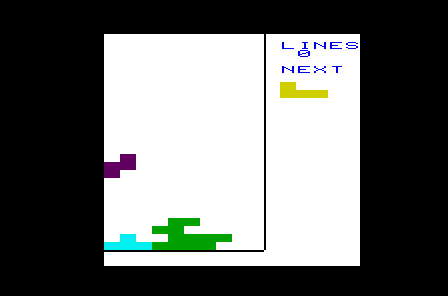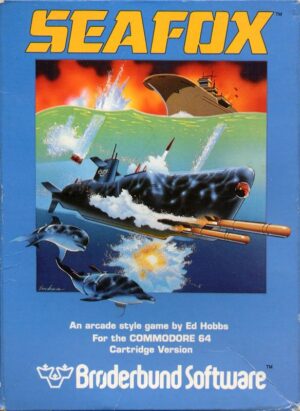Retro Replay Review
Gameplay
Zapactris delivers the classic falling-block puzzle action that enthusiasts of the original Tetris know and love. Despite fitting into a mere 1 kilobyte of code, it retains the core mechanics: tetrominoes descend one row at a time, you rotate and slide them into place, and when you complete a line it vanishes. There’s no slowdown gimmick or fancy physics—every piece behaves predictably, which feels both refreshingly familiar and deceptively challenging.
(HEY YOU!! We hope you enjoy! We try not to run ads. So basically, this is a very expensive hobby running this site. Please consider joining us for updates, forums, and more. Network w/ us to make some cash or friends while retro gaming, and you can win some free retro games for posting. Okay, carry on 👍)
Controls are razor-sharp. Using the VIC-20’s joystick or keyboard, you’ll drop pieces instantly or nudge them sideways with zero input lag. The limited control scheme—no soft drop, no hard drop, no extended spin allowances—means you must plan meticulously, as each misstep can bring the stack too close to the top. This discipline makes each cleared line feel earned in a way that more forgiving Tetris clones sometimes fail to capture.
What you won’t find here are the bonus point systems for clearing doubles, triples, or the majestic “Tetris” four-line clear. Zapactris opts for pure line removal scoring, rewarding each line equally. While some players might miss the thrill of pulling off multi-line combos, this democratized scoring approach keeps tension high and simplicity intact—every line is just as crucial as the last.
Graphics
Visually, Zapactris embraces the VIC-20’s retro charm. The color palette is limited to a handful of block hues on a dark background, but each tetromino is instantly identifiable. There’s no distraction of fancy animations—when pieces lock in place, they snap without flourish, creating a minimalist aesthetic that emphasizes gameplay over presentation.
The grid itself is crisp and legible, framed by simple borders that help you track your stack height. Occasionally, you might notice a flicker or two as the VIC-20 struggles to refresh the entire screen in real time, but this only adds to the authentic old-school feel. If you grew up on 8-bit systems, these visual quirks will feel like a warm embrace rather than a flaw.
While modern gamers accustomed to HD graphics might find Zapactris’s visuals austere, it’s precisely this no-frills presentation that underscores the programmer’s technical feat. Squeezing Tetris into 1 KB forced every pixel and color choice to serve a function—no extras, no fanfare, just the blocks.
Story
Unlike narrative-driven titles, Zapactris offers no plot or characters—its story is the story of constrained creativity. Originating in the 2002 Minigame Compo, a coding competition where size limits reign supreme, the game stands as a testament to Anders “Zapac” Carlsson’s ingenuity. He challenged both himself and the hardware, resurrecting Tetris on a system that never officially received it.
Every session you play is a nod to hacker culture and the early days of home computing, when programmers routinely pushed machines to their limits. There’s a sense of historical weight behind each cleared line. You’re not just matching blocks; you’re experiencing a piece of retro‐computing lore, a slice of digital archaeology that bridges the gap between past and present.
For many players, the narrative emerges from their own experience—each rising stack tells a story of near-misses, clever maneuvers, and last-second saves. While there’s no written plot, the emergent tension you feel as the pieces pile up becomes your personal storyline, fueled by the simple yet eternal quest to break your own high score.
Overall Experience
Zapactris is a love letter to simplicity and technical prowess. It may lack the bells and whistles of modern Tetris variants—no ghost piece preview, no advanced scoring, no multiplayer bells—but it doesn’t pretend to be anything other than a faithful, unadorned puzzle challenge. That purity makes it a standout for retro aficionados and minimalists.
The learning curve is steep but rewarding. You’ll find yourself honing spatial awareness and rapid decision-making in a brutally honest environment. Each press of the joystick is a commitment; piece placement matters more than ever, and the absence of secondary features means your focus never drifts from the well-worn battlefield of the playfield.
If you’re looking for a nostalgic trip or a bite-sized demonstration of programming wizardry, Zapactris hits the mark. It won’t replace your favorite modern Tetris game, but it offers a distilled experience that reminds you why the original concept was so compelling. For collectors, retro gamers, or anyone curious about 1 KB coding marvels, Zapactris is a must-try.
 Retro Replay Retro Replay gaming reviews, news, emulation, geek stuff and more!
Retro Replay Retro Replay gaming reviews, news, emulation, geek stuff and more!







Reviews
There are no reviews yet.